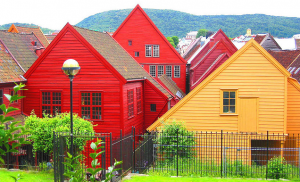Selecting paint colors for your walls can be a daunting task. There are so many colors to choose from! Some people simply feel stuck with the colors on the walls and live with them for years just to avoid the challenge of selecting a new color. Add to that the complexity of open floor plans and you can find yourself in a real dilemma.
Homes with open floor plans are a favorite because they have a sense of spaciousness that homes with numerous small rooms can’t offer. An open floor plan offers easy access from room to room making the home feel larger and making it a great space for entertaining.
The problem with this comes when you want to paint the walls. With an open floor plan, does the entire area have to be the same color?
The answer? Not necessarily.
You can paint the open area all the same color and define the spaces with different accent colors. For example, the walls can be a neutral color and the kitchen can be accented with reds, the family room with greens, and the dining room with browns. When the accent colors are used properly this concept can work.
However, playing it safe and only using one wall color throughout the space can also leave the space feeling bland and unfinished.
With an open concept floor plan it is best to use more than one color throughout the space. This can help to highlight architectural features and will create more definition and interest.
Selection of the colors needs to be done carefully. A common mistake people make is when they select random colors that compete with each other, or even worse, clash. This can break the room up too much and cause an overwhelming feeling that leaves your eyes with nowhere to focus.
The easiest way to select colors for your open floor plan is to select a color that you find pleasing for your living space and then choose two or three different shades of that same color to define each space of the open area, hallways, or architectural features.
You might choose to use the darkest shade in the dining room, the medium shade in the family room, and the lightest shade in the kitchen, for example. Or perhaps you would use the lightest shade to highlight architectural features such as pillars, built-ins, the hallway, or the entry area. The middle shade can be used for the family room, and the darkest in the kitchen and dining room. There are a number of different options.
You will find that the difference between two colors that sit next to each other on a color card is very subtle. You don’t have to choose colors that are consecutive on the color card. Instead you might try to choose shades that look good next to each other.
If you’d like to make even more of a statement, you can use totally different colors for each area. But you need to be careful to select complementary colors that do not clash.
You will want to consult a color wheel to see which colors look good together. Then you will want to unify the spaces by using accents of the colors in each room.
For example, if you paint the dining room with a shade of yellow and the family room with a shade of green, you will add elements to the family room, such as wall hangings or pillows, that have a similar shade of yellow as the dining room.
No matter which colors you select for the walls you will want to bring unity to the open floor plan with the transitional elements. This means that elements such as the doors, ceiling, and trim will all be the same color, typically white.
The key to selecting paint colors for open floor plans is to choose colors that don’t clash or compete with each other, but instead that emphasize the openness of the space, maintain the flow, and highlight the architectural features and design of the home. At the end of the day, the paint colors you choose should be the ones that you find the most pleasing.
To view more of Jennifer Couch’s articles, visit houseplansandmore.com!






